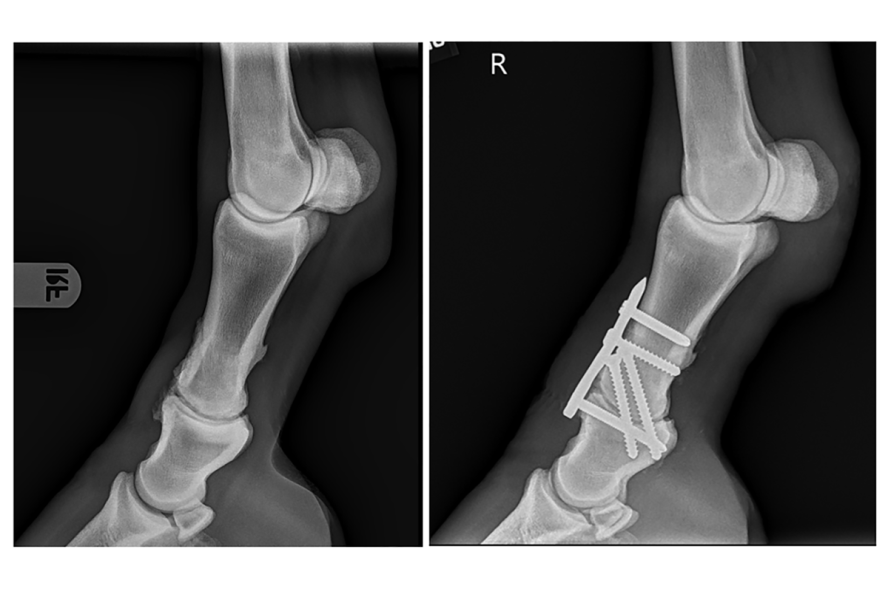-
About
- Leadership & Faculty
- News & Events
-
Academics
- Graduate
- Advanced Clinical Training
- Continuing Education
- Academic Departments
- Academic Offices
- Simulation Experiences
-
Student Life
- Offices
-
Research
-
Hospitals & Clinics
- Emergency Care
- Hospital Services
-
Community Outreach
- Volunteer
What is Arthrodesis?
Ask the Expert

What is arthrodesis?
Arthrodesis is a surgical procedure stabilizing a joint by fusing the bones across the joint. The surgery involves removing the joint cartilage and using surgical implants to compress and stabilize the joint. This allows the bones on either side of the joint to fuse together, eliminating movement and providing stability. The most commonly used surgical implants are plates and screws. However, other techniques may be used as well.
Why is arthrodesis performed?
Treatment of severe osteoarthritis is the most common reason to perform an arthrodesis. Your veterinarian may recommend it if medical management, such as joint injections and anti-inflammatories, are no longer effective. This can help relieve the pain associated with motion in the arthritic joint. Arthrodesis can also be performed to repair complex bony fractures that extend into the joint or to stabilize a joint that has sustained injury to the supporting soft tissue structures (torn ligaments or tendons). In horses, the most common joints for arthrodesis are the lower hock joints and pastern joints. These joints are “low motion” joints, and fusion of the joint still allows the horse to continue to have normal use of the limb.
What is the difference between arthrodesis and ankylosis?
Arthrodesis uses surgical implants to stabilize the joint while it is healing. Conversely, ankylosis involves joint fusion without the use of implants. Ankylosis can occur naturally due to the progression of severe osteoarthritis, or a facilitated ankylosis can be performed. Facilitated ankylosis can be achieved by a chemical injection used to destroy the cartilage or by surgically removing the cartilage, usually using a drill or laser. However, since the surgical implants are not in place to stabilize the joint during the healing process, patients receiving a facilitated ankylosis can experience incomplete fusion and longer healing times. Compared to ankylosis, arthrodesis typically reduces healing time, improves the quality of the joint fusion, and limits discomfort during the healing process.
Can my horse still be ridden after arthrodesis?
The ability of a horse to return to athletic use after an arthrodesis depends on the joint being treated. In low-motion joints (i.e., pastern, carpometacarpal, lower hock joints), the goal of arthrodesis is to allow the horse to return to full athletic use. However, some horses may continue to exhibit lameness after an arthrodesis and may not be able to achieve the same level of exercise. Arthrodesis of low-motion joints has a shorter recovery time and better long-term outcomes when compared to facilitated ankylosis. Arthrodesis of high-motion joints (i.e., fetlock, carpus) is considered a salvage procedure to make the horse pasture sound or breeding sound. Ankylosis of high-motion joints is not effective because there is too much movement to allow the bones to fuse together. High-motion joints require an arthrodesis with implants to stabilize the joint, allowing for successful fusion.
What is the aftercare for arthrodesis?
The aftercare for an arthrodesis will vary depending on the joint involved and the technique used. Anti-inflammatory medication and antibiotics are typically administered after the procedure to help the horse remain comfortable and prevent infection. In some cases, a cast may be applied to the limb for several weeks to help support the leg during the initial healing period. Other cases may only need a bandage for a few weeks until the skin incision is healed. Rehabilitation is a critical part of the aftercare following an arthrodesis. The surgeon will typically employ a gradually increasing exercise plan to facilitate the healing process.
Post-operative radiographs are used to help guide the rehabilitation process. Final healing of the arthrodesis can take 4 to 12 months and varies by surgical technique and joint.
Joseph Davis, D.V.M., DACVS (LA), is a large animal surgeon at Hospital for Large Animals and an assistant clinical professor in the Department of Clinical Sciences at Cummings School of Veterinary Medicine at Tufts University.